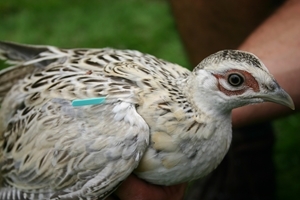Improving the reared bird
 In the late 1960s, we ran a national game-marking scheme involving several hundred estates where pheasants were released. The scheme provided an insight into overall trends in return rates and how releasing factors such as the date and age of birds at release might affect these returns (see Table 1). This work contributed to the development of the current pheasant releasing system. Long-term members can refer to an article by Bray in the Review of 1970.
In the late 1960s, we ran a national game-marking scheme involving several hundred estates where pheasants were released. The scheme provided an insight into overall trends in return rates and how releasing factors such as the date and age of birds at release might affect these returns (see Table 1). This work contributed to the development of the current pheasant releasing system. Long-term members can refer to an article by Bray in the Review of 1970.
We have started a new game-marking scheme, which we hope will enable us to look again at the current releasing system for pheasants and if necessary to refine it. We have been collecting some simple data from a large number of pheasant shoots. First, we need an accurate return rate for one or more pens on each estate participating in this study, and we would get this by wing-tagging a proportion of birds released into that pen.
Table 1: National game-marking survey data from 1969
| Release period |
Number of sites |
Total birds released |
Number shot |
Return rate (%) |
| June 16-30 |
50 |
9347 |
3064 |
32.7 |
| July 1-15 |
174 |
34962 |
11382 |
32.5 |
| July 16-31 |
212 |
32554 |
10222 |
31.4 |
| Aug 1-15 |
142 |
24332 |
7032 |
28.9 |
| Aug 16-31 |
80 |
10803 |
3078 |
28.8 |
| Sept 1-15 |
23 |
2569 |
640 |
24.9 |
| Total |
681 |
111567 |
|
|
The apparent decline of the return rate with release date may be a consequence of releasing mostly older birds in August and September. Many sites did not use release pens at all in those days and the older birds were more inclined to disperse far from release sites. We might expect a very different relationship today. Preliminary data from Clare Turner’s work on release pens (see Review of 2005) suggested that return rates may increase with later released birds.
To test whether different releasing strategies and management account for variation in return rates between sites, we would then collect information about the release specific to the individual pens from which we also measured the return rate. We can then pool data from our large sample of sites and look for relationships between return rates and whatever releasing factors we collect data for.
All estates are asked for information about their rearing-field methods, releasing strategy, and about management work/effort, for example disease management, feeding strategy and predator control in relation to the study pen(s). A researcher visits each pen on each participating estate to make assessments that require a standardised approach, for example in relation to habitat. All information will be kept confidential in a secure database.
To get accurate shooting return rates, participating estates look systematically for tagged birds on shoot days to provide an accurate estimate of the return for the pen. We realise that to tag and then look for tags on shoot days is extra work but, in return, each estate receives a report which provides a picture of the return from the participating pen in the context of the regional and national average. We will also provide participating estates with wings tags and a tagging gun if required.
Getting involved
We currently have about 70 release pens at about 50 sites involved in this study. We would like about 100 pens to fully investigate the various specific factors that we think might influence return rates of released pheasants:
- Source of birds and strain
- Rearing field practice
- Date of release
- Poult age at release
- Predator control on the estate
- Pen medication
- Pen size and stocking density
- Pen construction factors
- Habitat in and around the pen site
To get an accurate estimate of a return rate for a pen, we think participating estates will need to tag all the birds for smaller releases, say between 100 and 200, and as pens get larger, a decreasing proportion. So, for pens with in excess of around 2,000 birds, 500 would be sufficient. Participating estates would be provided with a tagging pack including a tagging training guide.
Contact Maureen Woodburn if you would like to hear more and to receive a tagging pack.